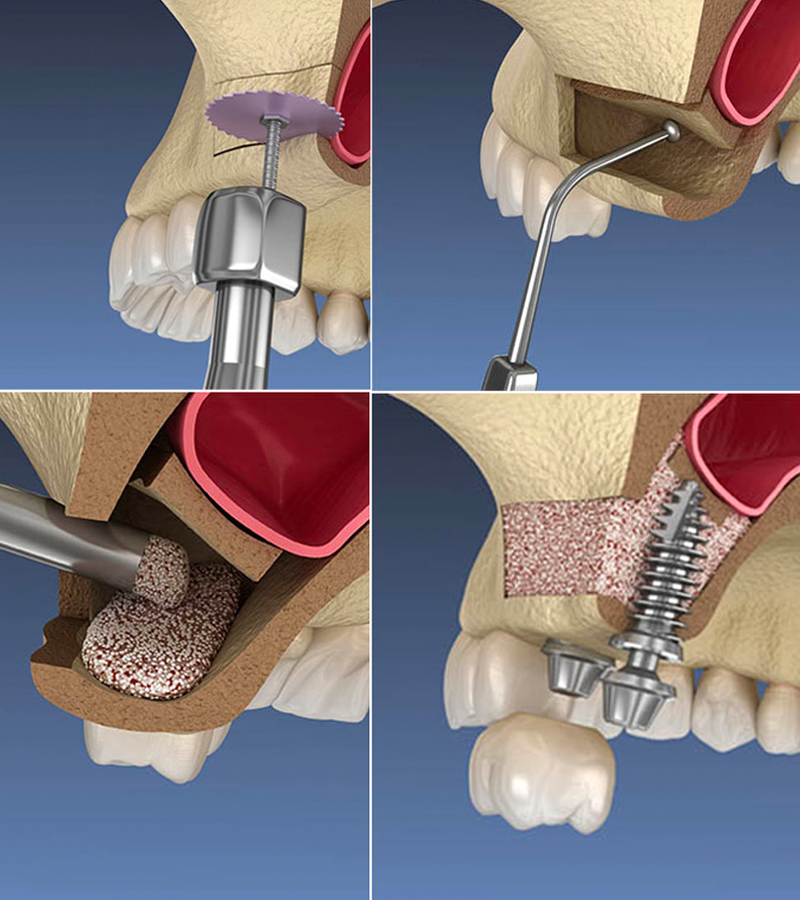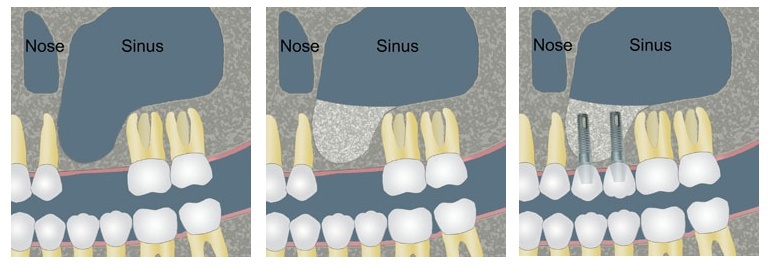Book an appointment

A sinus lift is surgery that adds bone to your upper jaw in the area of your molars and premolars. It’s sometimes called a sinus augmentation. The bone is added between your jaw and the maxillary sinuses, which are on either side of your nose.
At FMS, Sinus lift surgeries are performed by the IMPLANT TEAM
A sinus lift is done when there is not enough bone in the upper jaw, or the sinuses are too close to the jaw, for dental implants to be placed. There are several reasons for this:
The oral surgeon will open the gum tissue near your premolars and molars. The tissue is raised, exposing the bone. A small, oval window is opened in the bone. The membrane lining the sinus on the other side of the window separates your sinus from your jaw. This membrane is gently pushed up and away from your jaw. Granules of bone-graft material are then packed into the space where the sinus was. The amount of bone used will vary, but usually several millimeters of bone is added above the jaw.’
Once the bone is in place, the tissue is stitched closed. Your implants will be placed four to nine months later, depending on the graft material that was used. This allows time for the grafted material to mesh with your bone.

As an alternative, sinus augmentation can be performed by a less invasive osteotome technique. This technique is normally performed when the sinus floor needs to be lifted less than 4 mm. The osteotome technique is performed by flapping back gum tissue and making a socket in the bone within 1–2 mm short of the sinus membrane. The floor of the sinus is then lifted by tapping the sinus floor with the use of osteotomes. The amount of augmentation achieved with the osteotome technique is usually less than what can be achieved with the lateral window technique. A dental implant is normally placed in the socket formed at the time of the sinus lift procedure and left to integrate with bone. Bone integration normally lasts 4 to 8 months. The goal of this procedure is to stimulate bone growth and form a thicker sinus floor, in order to support dental implants for teeth replacement.

Book an appointment
FMS INTERNATIONAL DENTAL CENTER – ADVANCED DENTAL IMPLANT CLINIC
Door No. 8-2-293/82/A/725 Road, No. 37, Hitech City Rd, near Daspalla Hotel, CBI Colony, Jubilee Hills, Hyderabad, Telangana 500033
FMS DENTAL HOSPITAL
2nd Floor, Pranav Tej Towers, H. No. 1, 111/3/B, Gachibowli – Miyapur Rd, opp. KIMS Hospital, above HDFC Bank, Hanuman Nagar, Kondapur, Telangana 500084, India
FMS DENTAL HOSPITAL
MIG 155, KPR Complex, Rd Number 1, above State Bank Of India, Kukatpally, Hyderabad, Telangana 500072, India
FMS INTERNATIONAL DENTAL CENTER
MKS Square, Opp. Oberon Mall, NH Bypass, Padivattom, Edappally, Kochi, Kerala 682024, India